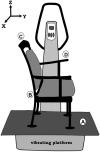Whole body vibration improves cognition in healthy young adults
- PMID: 24949870
- PMCID: PMC4065066
- DOI: 10.1371/journal.pone.0100506
Whole body vibration improves cognition in healthy young adults
Abstract
This study investigated the acute effects of passive whole body vibration (WBV) on executive functions in healthy young adults. Participants (112 females, 21 males; age: 20.5±2.2 years) underwent six passive WBV sessions (frequency 30 Hz, amplitude approximately 0.5 mm) and six non-vibration control sessions of two minutes each while sitting on a chair mounted on a vibrating platform. A passive WBV session was alternated with a control session. Directly after each session, performance on the Stroop Color-Block Test (CBT), Stroop Color-Word Interference Test (CWIT), Stroop Difference Score (SDS) and Digit Span Backward task (DSBT) was measured. In half of the passive WBV and control sessions the test order was CBT-CWIT-DSBT, and DSBT-CBT-CWIT in the other half. Passive WBV improved CWIT (p = 0.009; effect size r = 0.20) and SDS (p = 0.034; r = 0.16) performance, but only when the CBT and CWIT preceded the DSBT. CBT and DSBT performance did not change. This study shows that two minutes passive WBV has positive acute effects on attention and inhibition in young adults, notwithstanding their high cognitive functioning which could have hampered improvement. This finding indicates the potential of passive WBV as a cognition-enhancing therapy worth further evaluation, especially in persons unable to perform active forms of exercise.
Conflict of interest statement
Figures


Similar articles
-
Short-term effects of side-alternating Whole-Body Vibration on cognitive function of young adults.PLoS One. 2023 Jan 12;18(1):e0280063. doi: 10.1371/journal.pone.0280063. eCollection 2023. PLoS One. 2023. PMID: 36634088 Free PMC article.
-
The acute effects of whole-body vibration exercise on cortical activation in young adults: An fNIRS study.Behav Brain Res. 2025 Mar 5;480:115381. doi: 10.1016/j.bbr.2024.115381. Epub 2024 Dec 5. Behav Brain Res. 2025. PMID: 39644997 Clinical Trial.
-
Acute Effects of Whole Body Vibration on Inhibition in Healthy Children.PLoS One. 2015 Nov 2;10(11):e0140665. doi: 10.1371/journal.pone.0140665. eCollection 2015. PLoS One. 2015. PMID: 26524188 Free PMC article.
-
The effects and possible mechanisms of whole-body vibration on cognitive function: A narrative review.Brain Res. 2025 Mar 1;1850:149392. doi: 10.1016/j.brainres.2024.149392. Epub 2024 Dec 9. Brain Res. 2025. PMID: 39662790 Review.
-
The effects of whole-body vibration therapy on immune and brain functioning: current insights in the underlying cellular and molecular mechanisms.Front Neurol. 2024 Jul 31;15:1422152. doi: 10.3389/fneur.2024.1422152. eCollection 2024. Front Neurol. 2024. PMID: 39144715 Free PMC article. Review.
Cited by
-
External force to live long and prosper: A passive exercise classification framework.J Sport Health Sci. 2025 May 3;14:101052. doi: 10.1016/j.jshs.2025.101052. Online ahead of print. J Sport Health Sci. 2025. PMID: 40324751 Free PMC article.
-
Whole body vibration therapy and cognitive functions: a systematic review.AIMS Neurosci. 2023 May 18;10(2):130-143. doi: 10.3934/Neuroscience.2023010. eCollection 2023. AIMS Neurosci. 2023. PMID: 37426779 Free PMC article. Review.
-
Short-term effects of side-alternating Whole-Body Vibration on cognitive function of young adults.PLoS One. 2023 Jan 12;18(1):e0280063. doi: 10.1371/journal.pone.0280063. eCollection 2023. PLoS One. 2023. PMID: 36634088 Free PMC article.
-
Effects of Single or Multiple Sessions of Whole Body Vibration in Stroke: Is There Any Evidence to Support the Clinical Use in Rehabilitation?Rehabil Res Pract. 2018 Jul 30;2018:8491859. doi: 10.1155/2018/8491859. eCollection 2018. Rehabil Res Pract. 2018. PMID: 30155307 Free PMC article. Review.
-
Towards reporting guidelines of research using whole-body vibration as training or treatment regimen in human subjects-A Delphi consensus study.PLoS One. 2020 Jul 22;15(7):e0235905. doi: 10.1371/journal.pone.0235905. eCollection 2020. PLoS One. 2020. PMID: 32697809 Free PMC article.
References
-
- Kramer AF, Erickson KI, Colcombe SJ (2006) Exercise, cognition and the aging brain. J Appl Physiol 101: 1237–1242. - PubMed
-
- Hillman CH, Erickson KI, Kramer AF (2008) Be smart, exercise your heart: exercise effects on brain and cognition. Nat Rev Neurosci 9: 58–65. - PubMed
-
- Chan RC, Shum D, Toulopoulou T, Chen EY (2008) Assessment of executive functions: review of instruments and identification of critical issues. Arch Clin Neuropsychol 23: 201–216. - PubMed
-
- Smith EE, Jonides J (1999) Storage and executive processes in the frontal lobes. Science 283: 1657–1661. - PubMed
-
- Cardinale M, Lim J (2003) Electromyography activity of vastus lateralis muscle during whole-body vibrations of different frequencies. J Strength Cond Res 17: 621–624. - PubMed
Publication types
MeSH terms
LinkOut - more resources
Full Text Sources
Other Literature Sources

